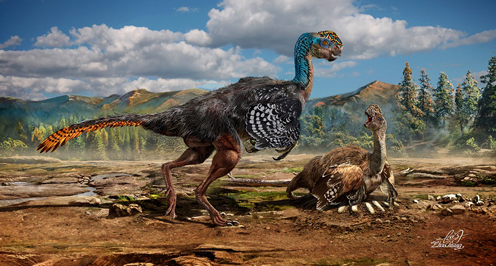Huanansaurus ganzhouensis – Demonstrating the Diversity of the Oviraptorids
Some very peculiar things can turn up at railway stations, just ask anyone who works in a lost property office. However, for one group of construction workers helping to build the new Ganzhou Railway Station in Jiangxi Province (southern China), they got rather a big surprise when they unearthed the partial remains of a new type of theropod dinosaur.
A New Dinosaur Species
The new dinosaur has been identified as a member of the Oviraptoridae family, an extremely bird-like group of dinosaurs, it has been named Huanansaurus ganzhouensis and it suggests that there were many different types of oviraptorids living in the same environment but each type may have evolved a different feeding and foraging habit.
An Illustration of H. ganzhouensis (Male and Female)
Picture credit: Chuang Zhao
Although no feather impressions have been found with the fossils, it is assumed that this lithe dinosaur was indeed feathered. The illustrator has also assumed that the males had different colouration when compared to the females. In this imagined scene, one of a breeding pair approaches the other which is sitting on a nest of eggs. More than two hundred oviraptorosaurian nests have been found in the Ganzhou area and this part of the world seems to have been a hot bed of oviraptorid evolution with a total of five genera now known from the strata around the city of Ganzhou.
Huanansaurus ganzhouensis
Size estimates vary, but based on skull measurements and comparisons with other Asian oviraptors, Everything Dinosaur’s team members estimate that Huanansaurus would have measured around 1.5 metres long and stood over a metre tall, making this dinosaur about half the size of its closest relative Citipati (C. osmolskae), fossils of which come from the Gobi Desert (Djadokhta Formation), that lies some 1,800 miles to the north-east of Jiangxi Province.
It is analysis of the beautifully preserved skull material that has permitted the research team to conduct a phylogenetic analysis placing Huanansaurus close to the Citipati genus in the Oviraptoridae family. Huanansaurus is distinct from the other four other types of oviraptorid discovered to date from the Upper Cretaceous rocks (Nanxiong Formation), located around Ganzhou city.
The four other types of oviraptorosaurs found in this area are:
- Banji long (named and described in 2010)
- Ganzhousaurus nankangensis (named and described in 2013)
- Jiangxisaurus ganzhouensis (also named and described in 2013)
- Nankangia jiangxiensis (named and described in that bumper year for southern Chinese oviraptorosaurs, 2013)
A Line Drawing of the Skull and Cranial Material (HGM41HIII-0443)
Picture credit: Journal Science with additional annotation by Everything Dinosaur
Edentulous – Lacking Teeth
Like most of the later oviraptorosaurs, Huanansaurus lacked teeth, the shape and size of the skull along with the morphology of the jaws suggests that lots of different types of feathered oviraptorid dinosaur were able to live in the same environment. These little dinosaurs co-existed as they probably had different foraging and feeding strategies. The prevalence of oviraptorosaurs in southern China indicates that other parts of Asia may have had different types of oviraptorid present within their biota, but these fossils may not have been found as yet.
The researchers involved in this study include scientists from Japan, South Korea, Uppsala University (Sweden), Henan Geological Museum and the Chinese Academy of Scientists. The fossils are currently stored in the vertebrate fossil collection of the Henan Geological Museum.
To view a selection of feathered theropod models: Wild Safari Prehistoric World Models.
Everything Dinosaur Comments on the Fossil Find
A spokesperson from Everything Dinosaur explained:
“In simple terms, the jaw shapes and sizes are different in the Jiangxi Province oviraptors. Although these feathered dinosaurs all lived at the same time, the very late Late Cretaceous and they shared the same environment, they probably specialised in eating different types of food. For example, the lower jaw tip of Banji long is very strongly curved downwards, whilst the same part of the jaw found in Nankangia jiangxiensis is not. Both Jiangxisaurus and the newly described Huanansaurus come somewhere in between these two extremes. It is likely that each type of dinosaur occupied a different ecological niche in the Late Cretaceous palaeoenvironment.”
More Research Required into Oviraptorids Like Huanansaurus ganzhouensis
What did oviraptor-like dinosaurs eat? That remains a bit of a mystery, we suspect that they were omnivorous with perhaps each animal adapted to eating different types of seed, fruit and nuts as well as catching and eating amphibian, small mammals and insects.
Everything Dinosaur stocks a range of oviraptors within the Papo model range: Papo Oviraptor Models and Dinosaur Figures.








Leave A Comment